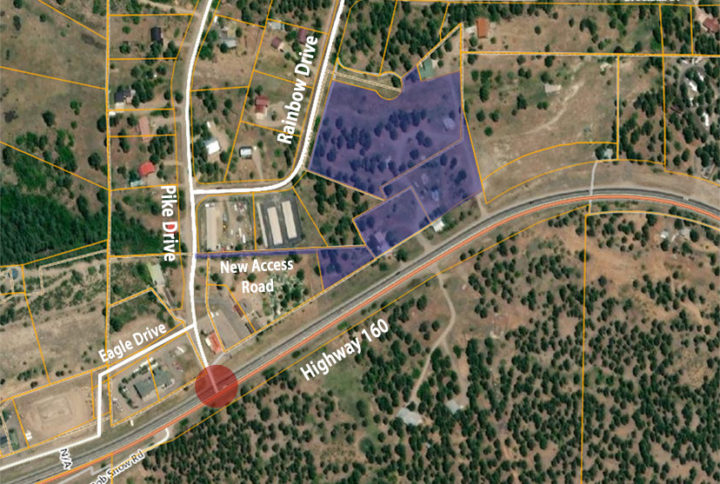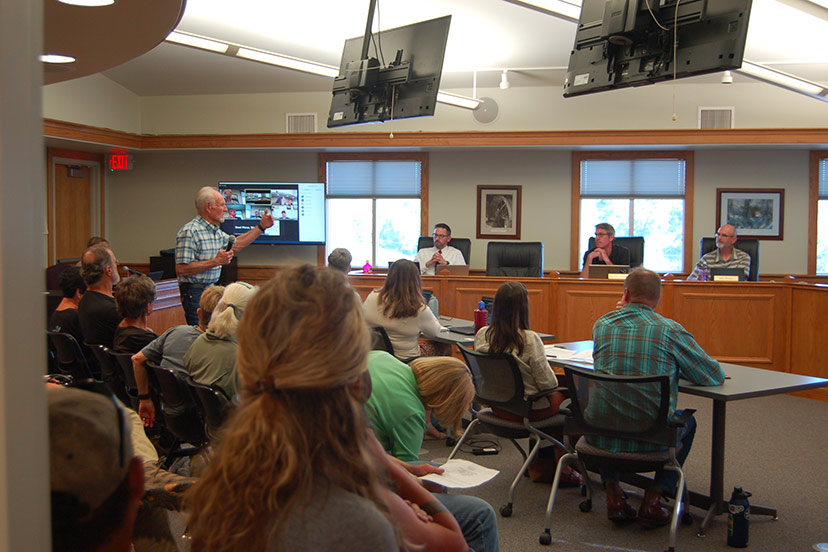The Archuleta Board of County Commissioners faced a packed audience at their regular Tuesday meeting, on June 7, mainly as the result of a particular agenda item.
E. Consideration And Approval Of Resolution 2022-50 Approving The Archuleta County Fee Schedule
Pursuant to C.R.S. 30-11-108, the Board of County Commissioners are charged with establishing fees charged for county services. This resolution updates certain fees. Suggested amendments or additions to the fee schedule are highlighted in yellow to ensure transparency in how the county represents changing fees.
Although the agenda item didn’t make it terribly clear which of the County’s many fees might be subject to change, the particular fee increases that had attracted the attention of many in the audience were related to the Archuleta County landfill operations.
In particular, the resolution proposed to double certain dumping fees.
Several people stepped up to question the wisdom of doubling trash fees, in an economy where so many other things had recently doubled in price. Housing, for one. Gasoline, for another. And where numerous other necessities have not doubled in price, but have nevertheless increased noticeably. Like food.
The end of the rainbow?
We thought maybe a pot of gold was awaiting us there… but it’s turning out to be a big stack of credit card bills.
The BOCC was not the only government board to face a full house of concerned citizens on Tuesday, however. We’ll get back to the debate about landfill price increases later on, but first we’re going to listen to the audience protests at the Tuesday Town Council meeting.
Another packed audience.

In the photo above, we can see that audience, and also to the right in the photo, seated at a table facing the Town Council, the defendants.
Or at least, I’m imagining they may have felt like defendants, in a trial. Local architect Courtney King and local developer James Prutsman were defending a proposed redevelopment of an abandoned RV park near the top of Put Hill (pronounced ‘Putt Hill’). The proposed redevelopment would include maybe three permanent buildings, about 22 RV sites, and spaces for five or six mobile food vendors in an adjacent ‘Food Court’.
Phase I of a potentially larger development, as I understand the proposal.
We discussed this project a month ago, in a previous editorial series, when it was being considered by the Town Planning Commission. You can read that editorial, here, but I will give you a short summary of the project.
Here’s the approximate area of the proposed development, shown in blue. Access to the property might be through a new access road connected to Pike Drive, also shown in blue:

The Colorado Department of Transportation (CDOT) now makes it very expensive — if not impossible — to connect directly to a state or federal highway from a property with highway frontage. So the developer is suggesting primary access to the development would be via Pike Drive or the Eagle Drive frontage road.
In the map above, we’ve indicated the existing Pike Drive-Highway 160 intersection with a red circle. This is widely recognized as one of the most dangerous intersections in Archuleta County.
Mr. Prutsman has many hoops still ahead of him, to jump through, but the question facing the Town Council on Tuesday was a fairly simple one. Should the zoning be changed, on this former RV park, to allow it to be used as an RV park?
Some might find this to be a curious situation. A developer is asking the Town government for permission to use a parcel of land, that had for many years served the community as an RV park — and had never been used as anything but an RV park — to once again be used as an RV park. The Town, in its wisdom, had overlaid the property with a zoning designation that prohibits the parcel to be used as an RV park.
Thus, the defendants were begging for permission to use an RV park as an RV park.
The neighbors to the north and west of the parcel, many of whom live on Rainbow Drive, had turned out in significant numbers to protest the proposed development. The situation is slightly awkward, however, because the proposed RV park is within the town limits, and the adjacent neighborhood is in the unincorporated county.
Whose rights should be protected, in such a situation? At the end of Rainbow Drive?
Community Development director James Dickhoff explained to the Council that the Planning Commission had endorsed the project, and that there might be an overall benefit to the community to allow Mr. Prutsman to continue jumping through hoops. (Not in so many words.) After about 55 minutes of discussion between the applicant and the Town staff and Council, mayor Shari Pierce invited the neighbors to share their concerns about the zoning change, and the audience provided about 30 minutes of potentially sensible arguments, exclusively in opposition to the development.
Here’s one of the neighbors:
“I was a participant two weeks ago here [for the Planning Commission hearing on the project], and one thing that we did not do, as taxpayers, was to demand a temporary moratorium on building.
“Until our elected officials here in Pagosa commit to fixing our failing infrastructure first, we cannot accomplish projects such as the Mill RV Park. I want to talk to you about water and sewage problems.
“According to ‘MyPagosa.org’ there are 15 building projects on the books. Apartment buildings, town homes, container homes, individual homes, even a major subdivision. The 1,000-unit high density project near the Elementary School is not even noted.”
(We will discuss that 1,000-unit subdivision later in this editorial series.)
“These last two [subdivision] projects front on Highway 160. Who can tell me what the expected population growth will be, from all these projects, when no one is tracking the people count of these potential projects? Back in 2009, Pagosa was fighting to secure the Dry Gulch Reservoir, contending that we could grow to 63,000 by 2055. How could we know? We lost that case, because Supreme Court Justice Hobbs wrote an opinion, that the state estimated our growth to be 35,000 to 42,000 by 2055.
“NOAA has now declared southwest Colorado as experiencing severe drought conditions. Our water resources come from snow melt. How does low water reserves and population growth make any sense?
“PAWSD manager Justin Ramsey quoted that Pagosa Springs has aging water lines with only a small population base to pay for it. Every year, water loss is happening through [water leaks] identified as a continuing problem.
“In 2012, the Town said they could not afford an ungraded $7 million sewage plant, which was projected to last 40 to 50 years. They contracted with PAWSD instead, to carry the effluent uphill to the Vista Plant. That plan failed miserably. It has since cost the Town $7 million to keep sending the brown stuff up the hill. We’re currently spending $7,700 a month for an emergency pump, to back up our potentially failing pumps. That means, spending an additional $90,000 a year…”
The neighbor had more to say, but she had reached the three-minute limit on testimony allowed by Mayor Pierce.

